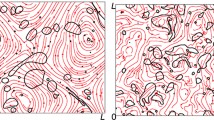Abstract
The aim of this work is to present a mathematical model of the motion of a one-component two-phase bubbly flow in one-dimensional geometry. Bubbles are assumed to be spherical and far enough from each other in order to exclude reciprocal interactions. The mathematical model is derived by means of a phase average operation and assuming a suitable description of the velocity field in the liquid phase, in the neighbourhood of the bubbles. Two different sets of experimental conditions are then simulated: a steady motion in a convergent–divergent nozzle and two different unsteady flows: i.e. two water hammer transients. Both the experimental conditions considered are well reproduced, indicating the validity of the proposed model.
Similar content being viewed by others
References
Mariano PM (2004). Some thermodynamical aspects of the solidification of two-phase flows. Meccanica 39: 369–382
Huo Y and Mueller I (2003). ‘Nucleation of droplets in a binary mixture. Meccanica 38: 493–504
Saurel R and Le Metayer O (2001). A multiphase model for compressible flows with interfaces, shocks, detonation waves and cavitation. J Fluid Mech 431: 239–273
Kiselev SP, Vorozhtsov EV and Fomin VM (1999). Foundation of fluid mechanics with applications. Birkhäuser, Boston
Lee WH and Lyczkowski RW (2000). The basic character of five two-phase flow model equation sets. Int J Numer Methods in Fluids 33: 1075–1098
Lyczkowski RW, Gidaspow D, Solbrig CW and Hughes ED (1978). Characteristics and stability analysis of transients one-dimensional two-phase flow equations and their finite differences appoximations. Nucl Sci Eng 66: 378–396
Drew DA (1983). Mathematical modeling of two-phase flow. Ann Rev Fluid Mech 15: 261–291
Yoshizawa A (2003). Statistical theory of compressible turbulence based-weighted averaging, with an emphasis on a cause of countergradient diffusion. Phys Fluids 15(3): 585–596
Saltz D, Lee W and Hsiang TR (2000). Two-phase flow analysis of unstable fluid mixing in one dimensional geometry. Phys Fluids 12(10): 2461–2478
Biesheuvel A and Wijngaarden L (1984). Two-phase flow equations for a dilute dispersion of gas bubbles in liquid. J Fluid Mech 148: 301–318
Preston A, Colonius T and Brennen CE (2002). A numerical investigation of unsteady bubbly cavitating nozzle flows. Phys fluids 14(1): 300–311
Wang YC and Chen E (2002). ‘Effects of phase relative motion on critical bubbly flows through a converging-diverging nozzle. Phys fluids 14(9): 3215–3223
Espinosa-Paredes G, Cazarez-Candia O and Vazquez A (2004). Theoretical derivation of the interaction effects with expansion effects to bubbly two-phase flows. Ann Nucl Energy 31: 117–133
Espinosa-Paredes G, Nunez-Carrera A and Martinez-Mendez EJ (2005). Interaction forces model on a bubble growing for nuclear best estimate computer codes. Ann Nucl Energy 32: 1546–1566
Alimonti C, Boccardi G, Celata GP (2003) Water two-phase flow through a convergent-divergent nozzle with variable backpressure: check of calculation cethod to estimate mass flow rate and critical flow conditions. Proceeding of seventh international conference of multiphase flow in industrial plants, pp 1–10
Fletcher B (1984). Flashing flow through orifices and pipes. CEP 3: 76–81
Henry RE and Fauske HK (1971). ‘The two phase critical flow of one component mixtures in nozzles, orifices and short tubes’. J Heat Trans 5: 179–187
Muir JF, Eichhorn R (1963) Compressible flow of an air–water mixture through a vertical two-dimensional converging-diverging nozzle. In: Proceedings of the 1963 Heat Transfer and Fluid Mechanics Institute, Stanford University Press, Stanford, CA, pp 183–204
Pezzinga G (1999) ‘Dissipazioni nei transitori di colpo d’ariete in presenza e in assenza di cavitazione’. Atti del XIV Congresso Nazionale AIMETA, Como
Cannizzaro D, Pezzinga G (2001) Dissipazioni termodinamiche nei transitori con cavitazione. Atti del XV Congresso Nazionale AIMETA, Taormina
Wylie EB, Streeter VL (1993) Hydraulic Transients. Prentice Hall, Englewood Cliffs, NJ
Marchi E, Rubatta A (1980) Idraulica-Meccanica dei fluidi: principile applicazioni idrauliche. UTET, Bologna
Fujii T and Akagawa K (2000). ‘A study of water-hammer phenomena in one component, two-phase, bubbly flow. JSME Internat J B-43(3): 386–392
Author information
Authors and Affiliations
Corresponding author
Rights and permissions
About this article
Cite this article
Rocca, M.L., Mele, P. & Boccardi, G. Steady and unsteady motion of one-component two-phase bubbly flow in 1-D Geometry. Meccanica 41, 483–499 (2006). https://doi.org/10.1007/s11012-006-0005-8
Received:
Accepted:
Published:
Issue Date:
DOI: https://doi.org/10.1007/s11012-006-0005-8




